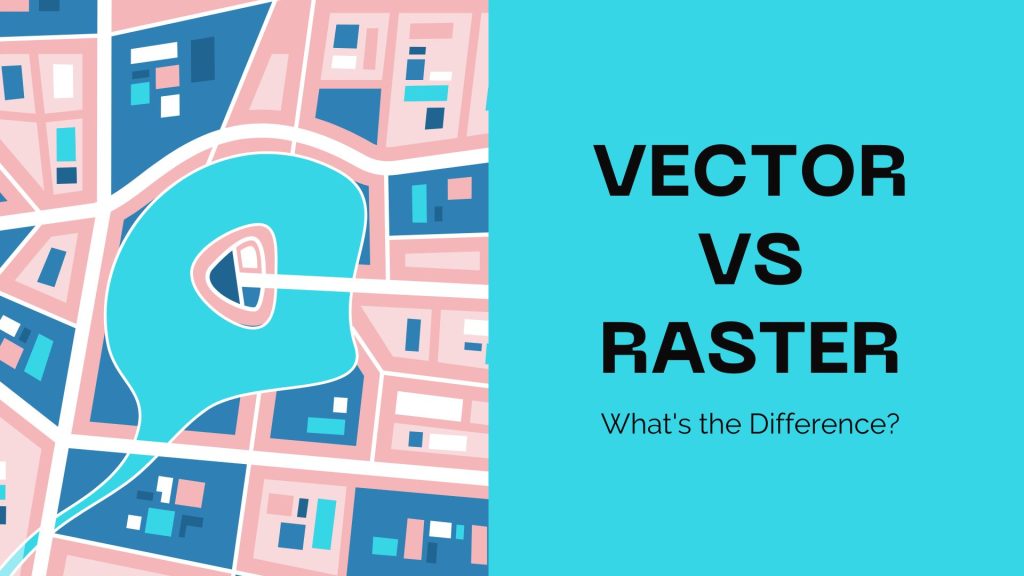What’s the Difference Between Vector and Raster in GIS

Vector and raster are two primary data models in Geographic Information Systems (GIS) for storing, processing, and analyzing spatial data.
Today, we’re going to examine the differences between these two data models including their advantages and disadvantages.
What is a Vector GIS Data?
In GIS, vector data represents spatial information as individual points, lines, and polygons. These features are defined by their geometric properties. This includes their coordinates and vertices. It can also include additional attributes, such as names, IDs, and descriptive information.
There are three primary types of vector features in GIS:
Points: Points represent discrete features that have a specific location, such as a building, a tree, or a water well. A point is defined by its X and Y coordinates. But it may also include additional attributes such as strings, floats and doubles.

Lines: Lines are used to representing features that have length and direction, such as roads, rivers, or pipelines. A line is defined by a series of connected points, or vertices. Similar to points, it may also include additional attributes such as its name, width, or material.
Polygons: Polygons are used to represent features that have an area, such as land parcels, lakes, or administrative boundaries. A polygon is defined by a series of connected lines, or edges, that encloses a region.
GIS professionals use vector data for mapping and analysis. For example, we use vector data for calculating distances between features, performing network analysis, or geoprocessing. We can store vector data in various file formats, such as shapefiles, geodatabases, or KML, which can be edited, queried, and displayed using GIS software.
What is a Raster GIS Data?
In GIS, raster data represents spatial information as a grid of cells or pixels. Each cell contains a value that represents a specific attribute or feature of the surface being modeled. Raster data can represent a wide range of continuous phenomena, such as temperature, elevation, rainfall, or land cover.

Raster data is typically stored as an image file, with each pixel representing a specific location and attribute value. The resolution of the raster data is determined by the size of the cells. Higher-resolution datasets contain smaller cells and more detailed information.
GIS professionals use raster data for terrain analysis, remote sensing, and image processing, such as generating digital elevation models, calculating slope and aspect, or classifying land cover. Raster data can be manipulated using various GIS software tools, such as overlay analysis, distance calculations, and spatial statistics.
Examples of raster data formats commonly used in GIS include GeoTIFF, GRID, and ASCII. The size of raster data can be large, which requires powerful computing and storage capabilities for processing and analysis.
A Comparison of Vector vs Raster
Vector data represents spatial features as individual points, lines, and polygons. Whereas raster data is composed of cells or pixels that represent a continuous surface, such as elevation or temperature. Both contain various GIS formats for storage.
Here are some key differences between vector and raster data:
| Component | Vector Data | Raster Data |
|---|---|---|
| Data Structure | Vector data is composed of discrete points, lines, and polygons that are defined by their geometric properties, such as coordinates, vertices, and attributes. | Raster data is structured as a grid of cells or pixels, where each cell has a value representing a certain attribute. |
| Spatial Accuracy | Vector data is typically more spatially accurate because it represents the exact location of features in the real world | raster data approximates the surface it represents by assigning a value to each cell based on the pixel size. |
| Data Size | Vector data tends to be smaller in size than raster data because it only stores the coordinates and attributes of individual features. | Raster data, on the other hand, can contain large amounts of information, especially if the resolution is high. |
| Processing Capabilities | Vector data is better suited for discrete, point-based analysis such as calculating distances between features | Raster data is well-suited for continuous, surface-based analysis such as terrain analysis, or image classification. |
Conclusion
In summary, both vector and raster data models have their advantages and disadvantages. Choosing the appropriate data model for a specific GIS application depends on the type of analysis required and the available data.
We’ve also provided an in-depth comparison of data structure, spatial accuracy, data size, and processing capabilities. Did we miss anything? Please let us know with a comment below.
